Key in a search term below to search our website.
Key in a search term below to search our website.
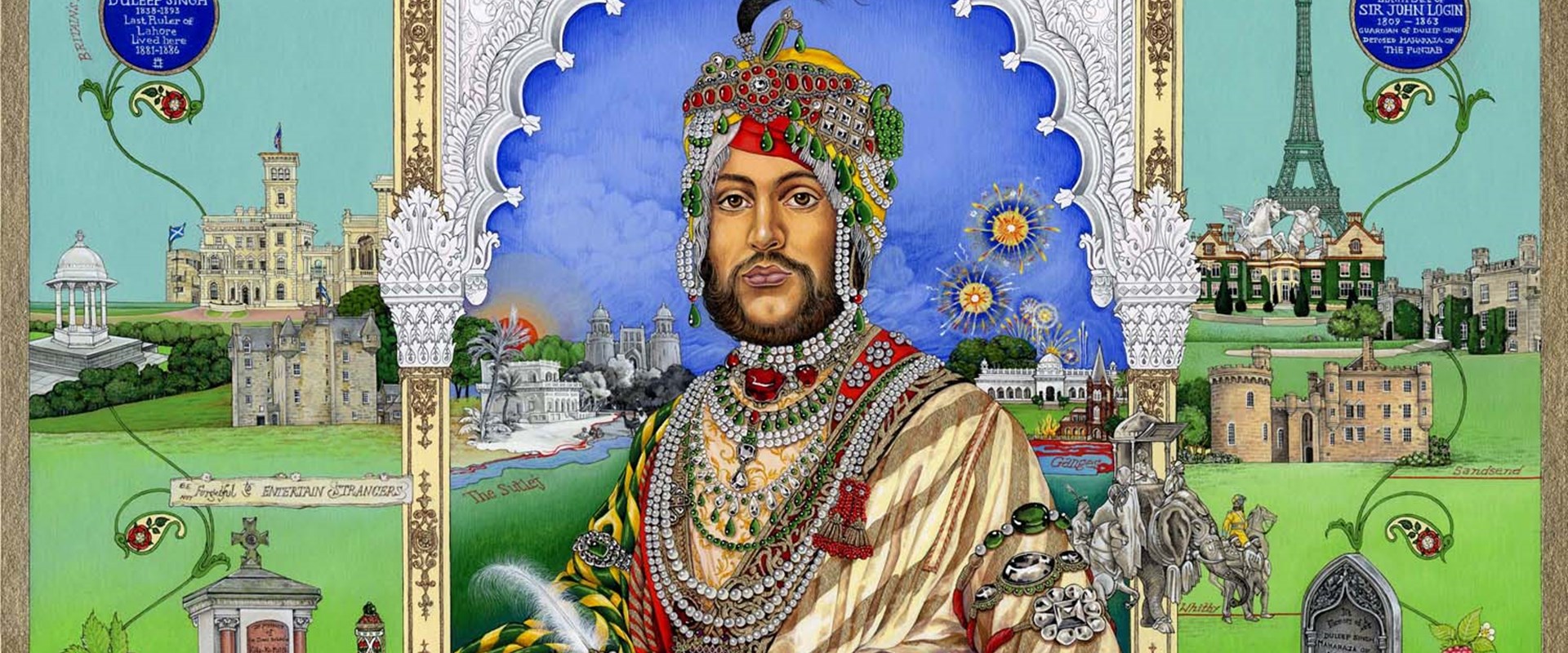
Casualty of War: A Portrait of Maharaja Duleep Singh is by renowned British Sikh artists, The Singh Twins. As the last ruler of the Sikh Empire, Duleep Singh was deposed from the throne by the East India Company and exiled to Britain.
Date
2013
Painted by
The Singh Twins
Media
Poster paint, gouache, gold, dust, mountboard
Dimensions
Height 635mm, width 670mm
On display
Artistic Legacies, Level 5, National Museum of Scotland
Museum reference
This painting was created as a response to pieces of jewellery in our collection which once belonged to Duleep Singh. Painstakingly rendered in all their details, the painting highlights their connection to one of the most important figures of British-Sikh history.
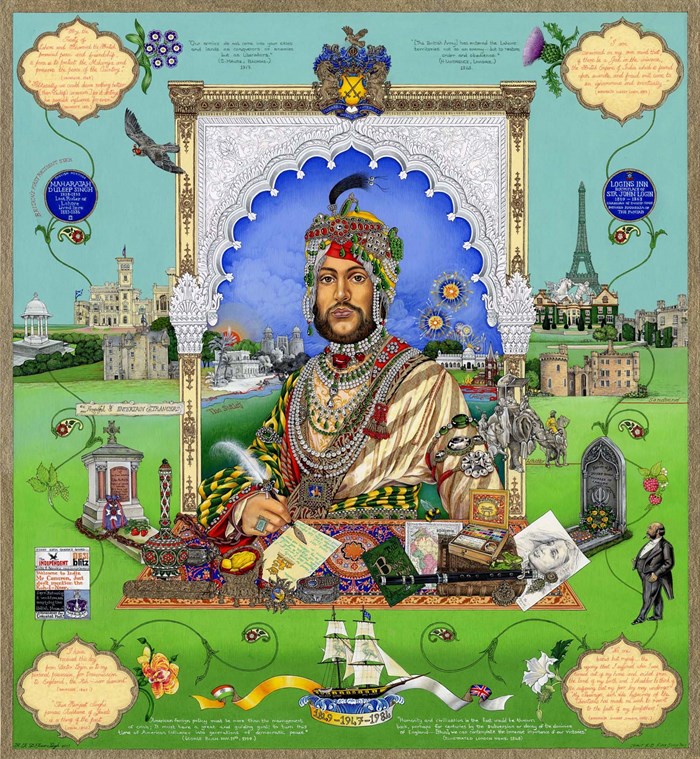
Above: Casualty of War: A Portrait of Maharaja Duleep Singh © The Singh Twins: www.singhtwins.co.uk The portrait is painted with water colour/poster paint and metallic gilding gold dust on mountboard.
Duleep Singh is depicted in all his splendour as the artists imagined him in his rightful position as Sikh emperor of the Punjab. He wears the Sikh turban, the royal seal ring and the imperial black plume of Kingship.
He is adorned with some of the most famous jewels from the Lahore Treasury including a ruby necklace, an emerald belt and, around his left arm set between two drop-shaped diamonds, the legendary Koh-i-Noor diamond, the ultimate symbol of sovereignty and power.
The gateway and a pavilion of Lahore Fort recall the places of his childhood.
The Sutlej River in front of them is stained red with the blood of those who died during the two Anglo-Sikh Wars.
The river marks the end of Sikh sovereignty as does the sun on the horizon, which can be seen as setting or rising, denoting the fall of the Sikh Empire and the rise of the British Empire in India.
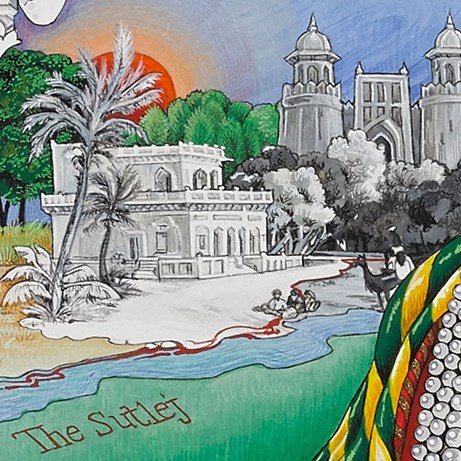
Two buildings at Fatehgarh, the place of Duleep Singh’s exile in India, are depicted. In the background there is the white bungalow of his guardian, John Login. It still exists today, while Duleep Singh’s bungalow as well as the church in the foreground were destroyed during the Indian Rebellion (Mutiny) in 1857-1858.
With this detail the artists allude to the failed promises by the British to protect Duleep Singh’s interests in India to which the quotation by Lord Dalhousie from 1848 in the top left medallion refers.
The fireworks relate to Duleep Singh’s first birthday as the deposed Maharaja in 1849.
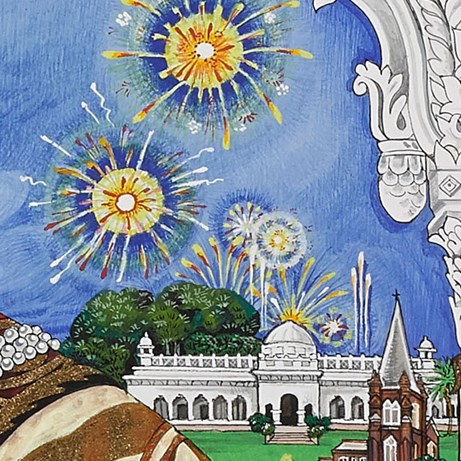
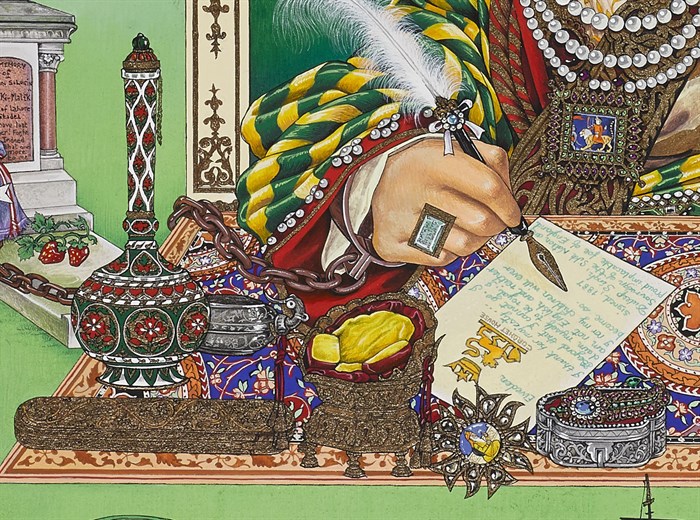
The oblong pen case, enamelled bottle, and silver container with bird-shaped stopper are amongst Duleep Singh’s personal possessions in the collection of National Museums Scotland. Together with the square breast pendant Duleep Singh is wearing on a pearl necklace they were sold at an auction by his son and heir Prince Victor in 1899.
Next to them the artists chose to depict items from the dispersed Sikh Treasury at Lahore - the Golden Throne, Maharaja Ranjit Singh’s Order of Merit and the turban aigrette (kalgi) of the tenth spiritual leader of the Sikhs, raising the question of cultural ownership.
While still in India Duleep Singh was educated in the faith and values of Victorian society to become a British gentleman. The group of objects displayed on the right hand side of the Kashmir shawl in front of him refers to the different subjects in which he was trained. Although he continued to study Urdu and Persian, he also had to learn English, ‘The Boy’s Own’ among his reading.
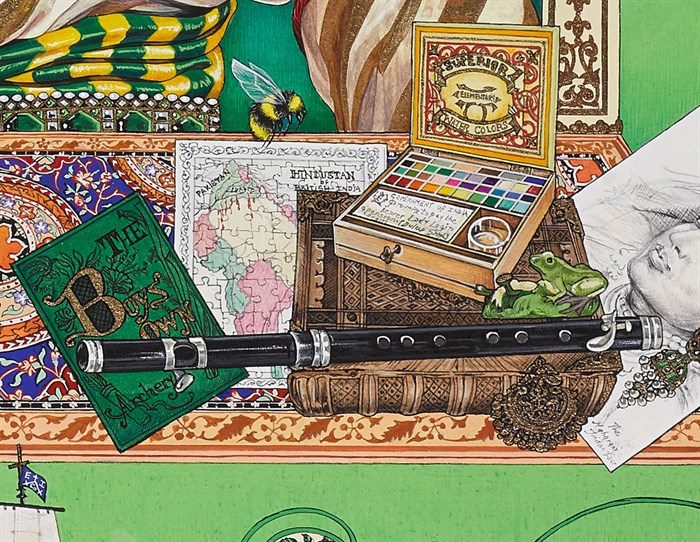
In addition Lady Login, his guardian’s wife, sent him a paint-box, geographical puzzles and mechanical toys (frog) from England for his amusement. In Fatehgarh he began to play the flute. It was also here that he converted to Christianity, which is symbolised by the antiquarian book, a faithful copy of the Bible the Governor-General of India, Earl of Dalhousie, presented to Duleep Singh on his departure from India.
Several elements in this painting, such as the Indo-European archway under which Duleep Singh is depicted, highlight the dual cultural influences on his identity.
Despite the efforts to make him English he retained a sense of Indianness throughout his life and finally re-converted to Sikhism. As a reminder of this, the artists added a Khanda, the emblem of Sikh religion, to the headstone of Duleep Singh’s grave.
It emphasises the significance of his Christian burial at Elveden Parish Church, Suffolk as a symbolic act to ensure that his rebellion would not challenge British rule in India even after his death.
The standing figure of Duleep Singh in western attire is a copy of a caricature by Spy, published in Vanity Fair in 1882. His diminished stature represents him as the ‘tamed’ English Christian gentleman, the role which the British establishment wanted him to assume.
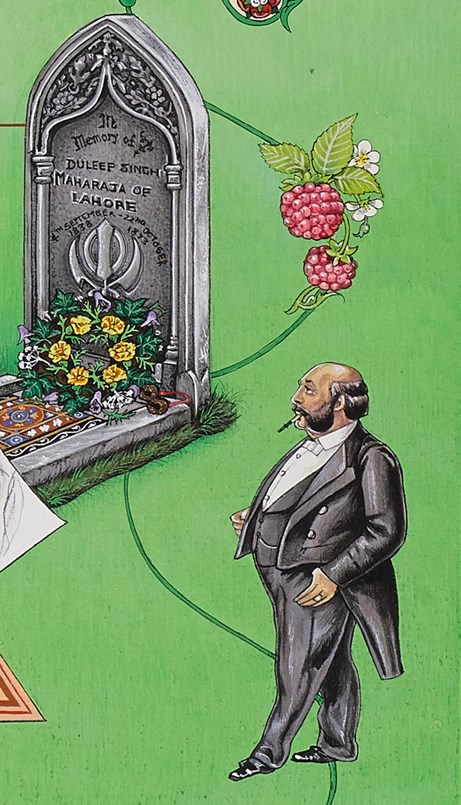
In 1993, the Maharaja Duleep Singh Centenary Trust commissioned a coat of arms to mark the centenary year of his death.
As a historical figure and Britain’s first resident Sikh, Duleep Singh continues to be relevant today. His life story is inextricably tied to British-Indian and Anglo-Sikh history, politics and culture in the past and present.
A lasting legacy of British rule in the Punjab, the Sikh homeland was torn apart as a result of the Partition of India in 1947. The map in front of Duleep Singh with a bleeding Punjab and the name of Pakistan written next to it alludes to this tragic moment.
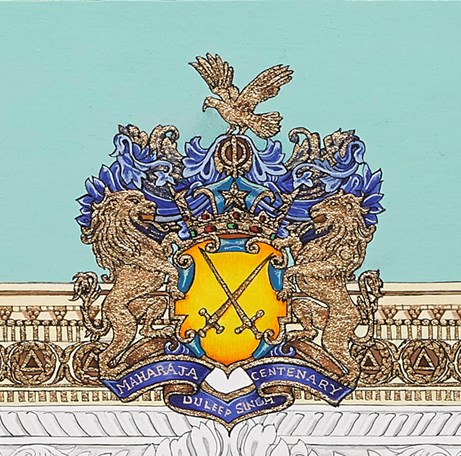
John Login, a surgeon in the service of the East India Company, became the guardian of the deposed Maharaja Duleep Singh following the annexation of his kingdom by the British.
The inscription on Login’s tombstone was modified by the artists to refer to both, his role as keeper of the Lahore treasury and the feelings of grief which Duleep Singh expressed on the occasion of his death. His ambivalent relationship with Login is expressed by the shackles leading from the monument to Duleep Singh’s wrist. Login clearly took a personal interest in him. First and foremost, however, it was a service he rendered to the British Crown and for which he was made a knight.
John Login’s birthplace in Stromness, Orkney is referenced by the artists in the painting through the blue commemorative plaque.
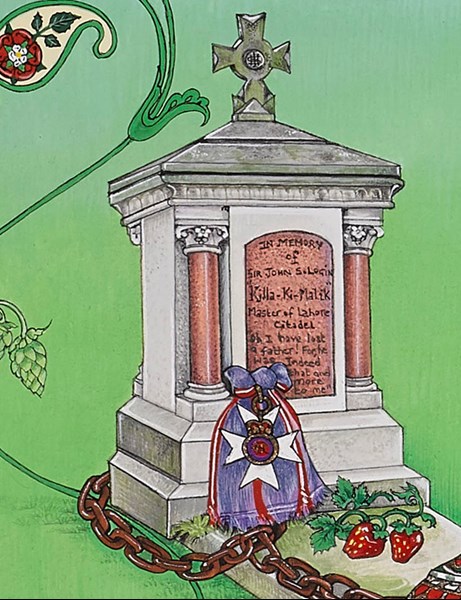
This interpretation is based on The Singh Twins’ Artists Commentary, 2014.